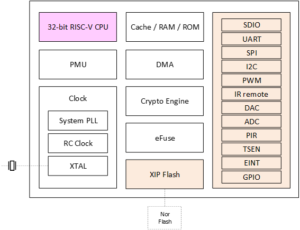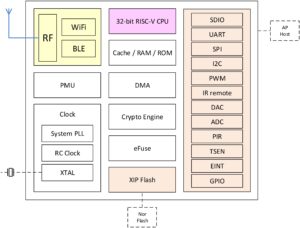I normally don’t do “scoops”, but as I write this, I can find no other pages on Google in English mentioning the Bouffalolabs BL562 and BL564 RISC-V chips. Even Bouffalab’s own page is pretty scant right now. (I’m writing this late on 2021-03-31 and no, this isn’t April fool. Maybe it is and I’ve fallen for it, but it seems terribly non-funny…) However, this seems like a very interesting contender in the low-power RISC-V processor market. It’s very likely a subset of the already-successful BL602/BL602, but without the 2.4Ghz radios that give it WiFi or Bluetooth. This also means the parts of the chip that have the most contentious NDA requirements for certification are simply not there.
Comparing Boufallolab’s own overview sheets of the BL562/4 and BL602/4 really highlights that only the yellow block, the RF radios, are different. The pin counts are the same as BL602/4, with at 32 or 40 pin QFN packages. It’s very likely the same RISC-V core running at speeds up to 192Mhz and with 276KB of RAM and 128KB of flash ROM.
It seems likely they’re pin-compatible, but we don’t yet have specification sheets with that level of information that I can find.
BL602 is already a price leading choice for low-end designs, with single-piece pricing of about $1USD. It’s easy to imagine that bulk orders can reduce by that a third or more. We can probably look to the BL602 for real-world performance measurements. The clock speed over the 108Mhz Gigadevices GD32VF103 family has given it a hand up in my own measurement. (I don’t have formal numbers.) GD32V, probably the most natural device to compare these two, ships in QFN36, LQFP48, LQFP64, and LQFP100 packages, so it has more I/O, notably USB support, which is absent in BL562.
This entry is a bit of a surprise as the medium (“runs Linux”) and high end(“runs a graphical desktop”) developments in RISC-V have been much publicized, it’s important to remember that not everything is IoT or needs to be able to render Netflix at 4K. With a smaller size, lower pin count, we score another gain of modernization. While GD32V’s 32K (max – there are smaller ones) of memory can feel a bit cramped, the 276KB of RAM may feel downright luxurious in some designs.

BL562
General purpose RISC/V SoC

BL602/604
RISC-V core with 802.11 and Bluetooth
As a general-purpose RISC-V processor, this is sure to score some commercial design wins where pennies count and hobby interest, where good development tools matter. Bouffalo Labs, in cooperation with SiFive, have an established SDK that’s been picked up by Pine64 and SeedStudio. There has been some jockeying lately at high-end hobbyist or media-player class devices, so it’s refreshing to see another player come back, wearing a slightly different costume, with a solid part in the dollar (or less?) market that’ll keep our rectangles blinking.
Assuming it’s the same RISC-V core (surely!) as Bl602, it’ll build on the established SDK provided by Boufallo and forked by Pine64 for their PineCone and PineNut lines and by Sipeed for their BL602 product and DoIt for DT-BL10.
Epilogue
Is it a scoop? I don’t really care. I’m always astonished how quickly things get to the likes of CNX, Reddit’s/r/risc-v, and the Twitter buzz. There is, of course, the time dilation between tech in China and the Western World. I was clicking around on Boufallo’s site, trying to find information on yet another part, and fiddled with the URL when I landed on BL-562.
At least for some short time, I think I have a reasonable claim on “first” and maybe even “most comprehensive”. 🙂
